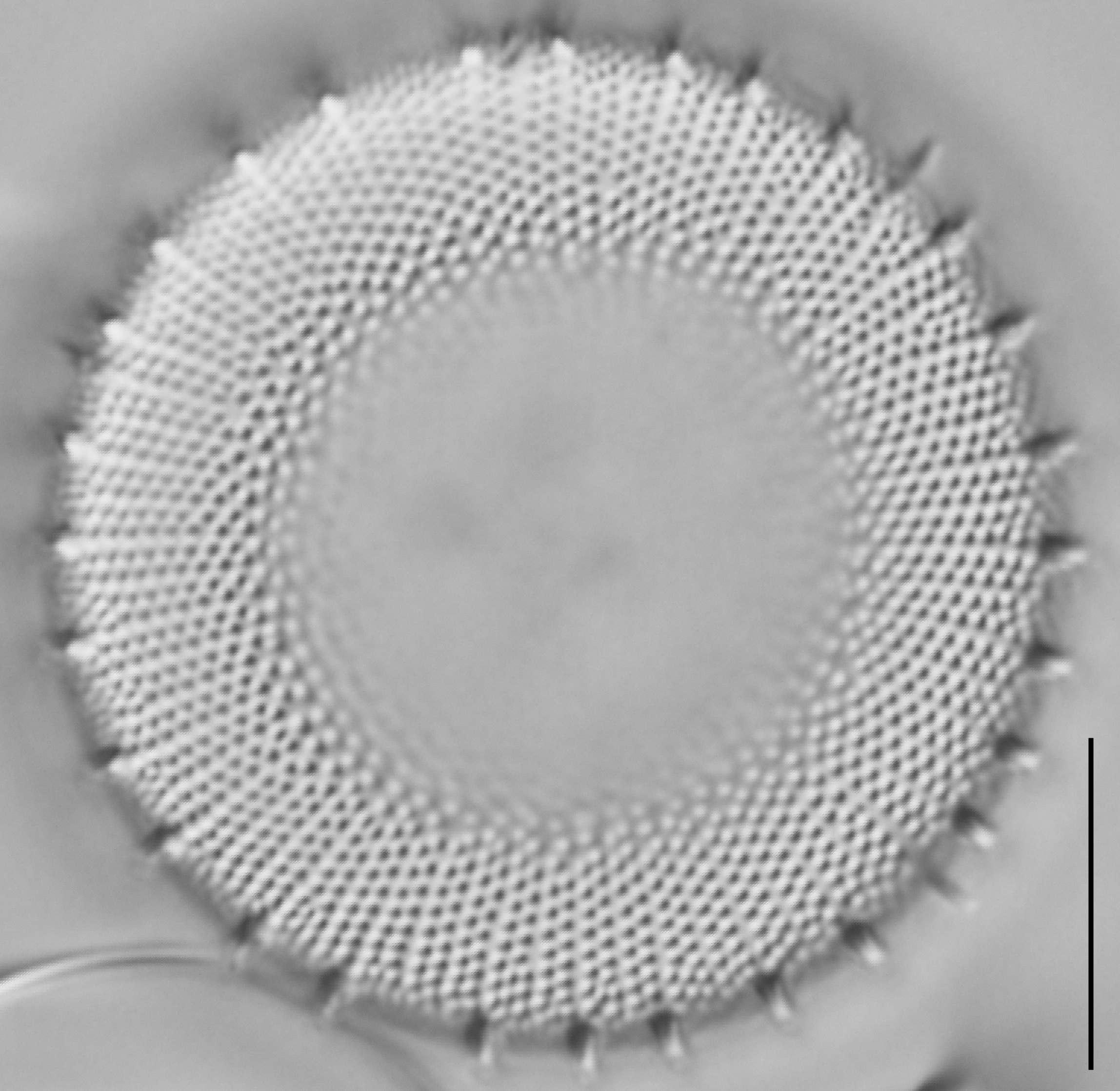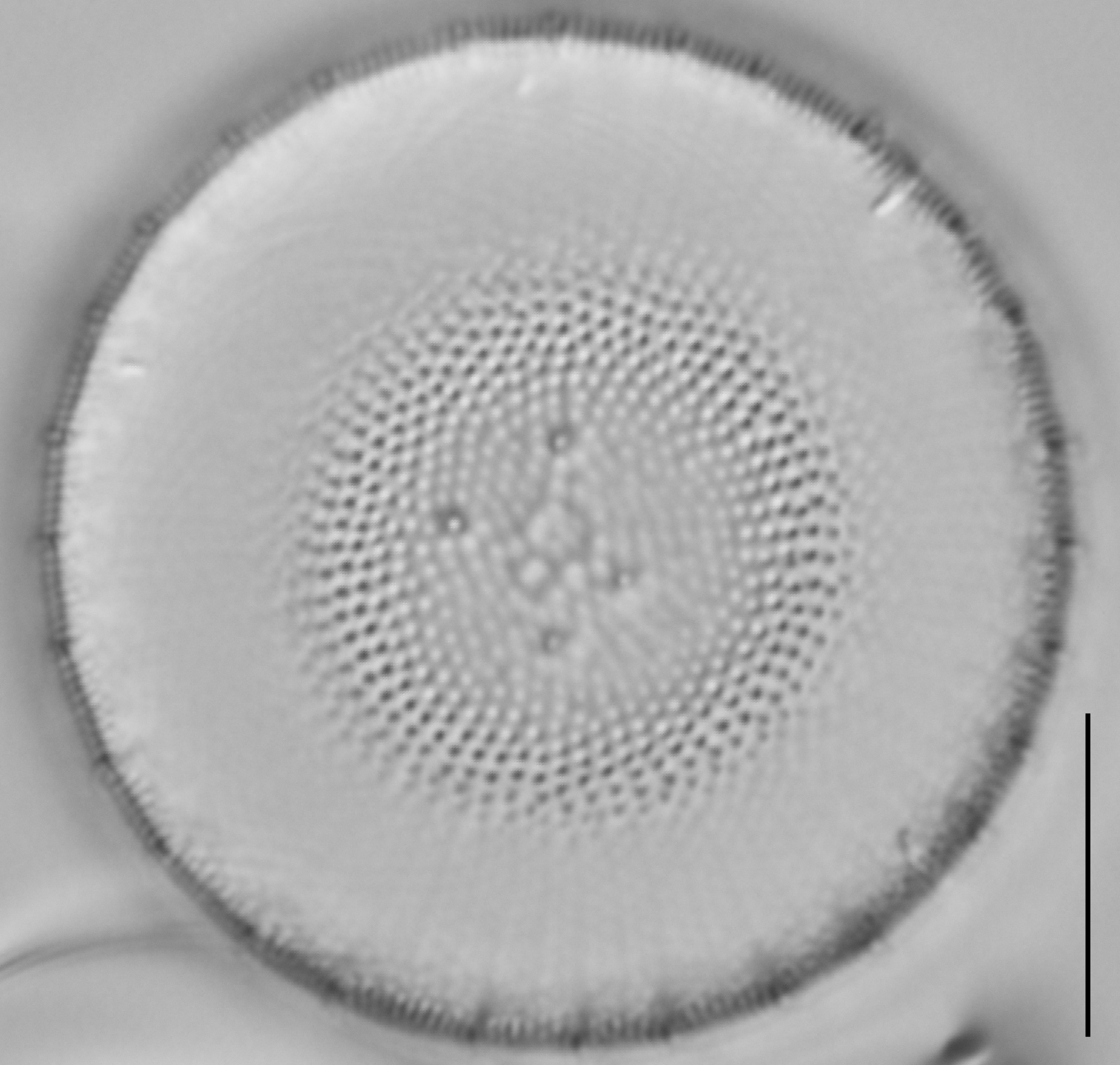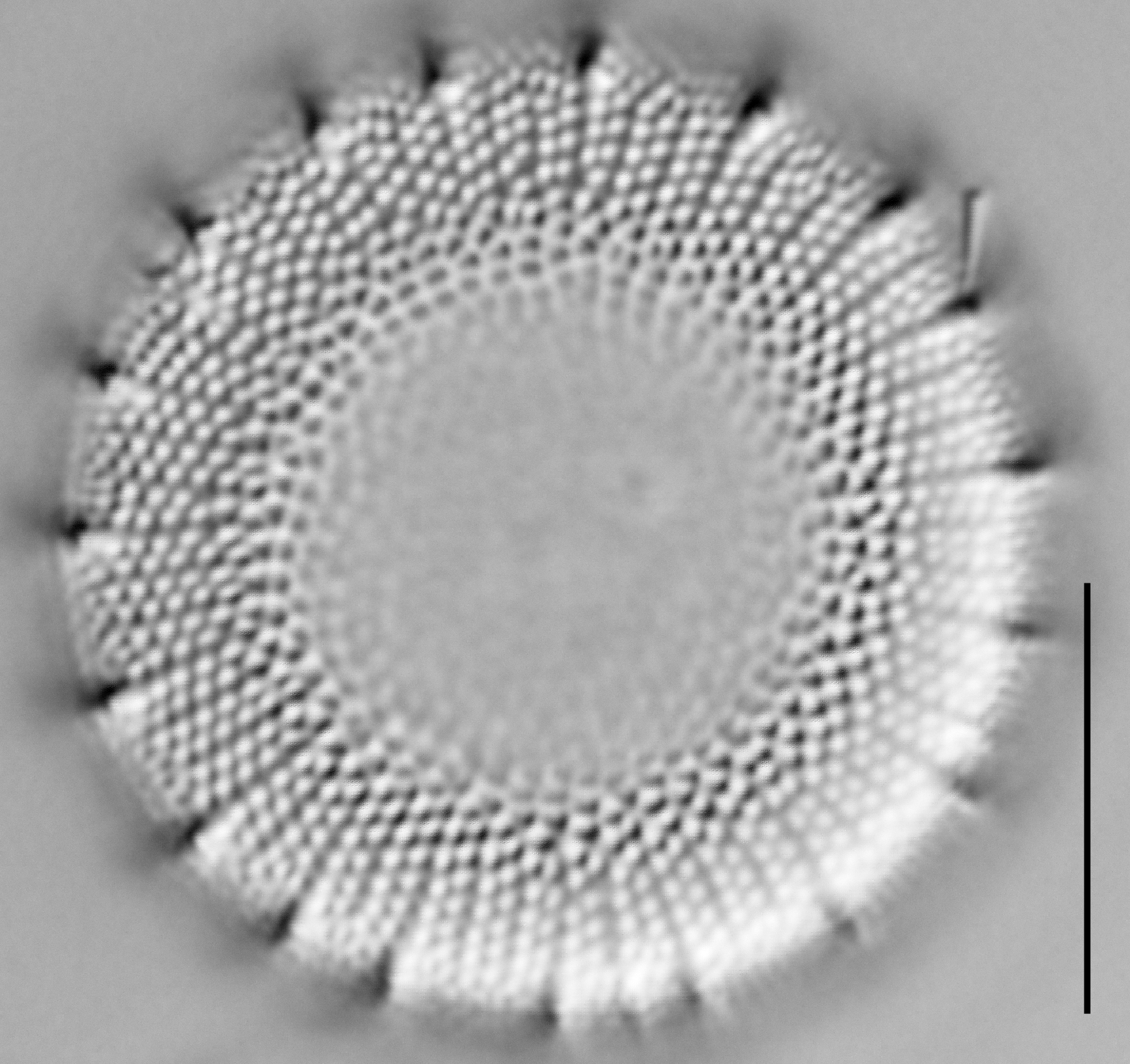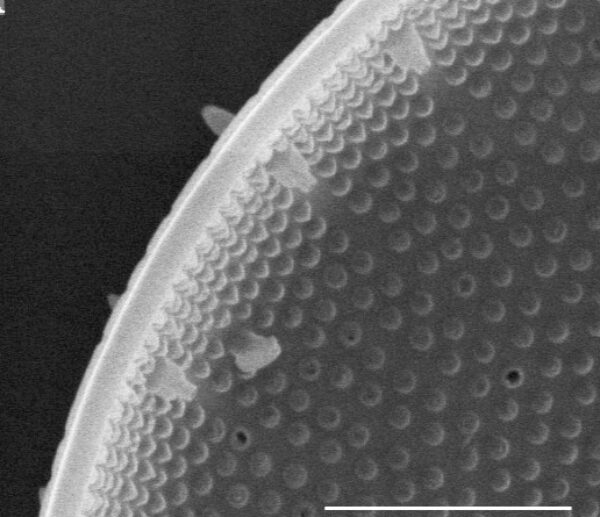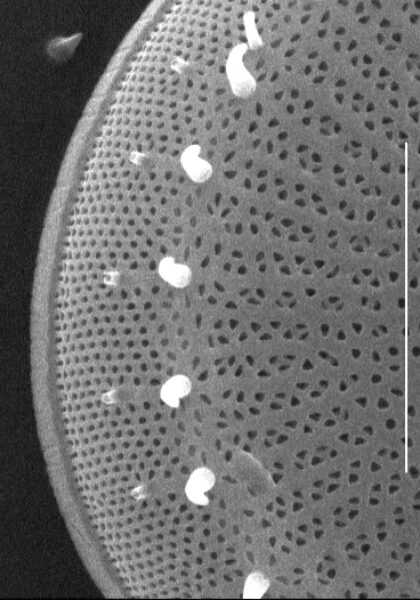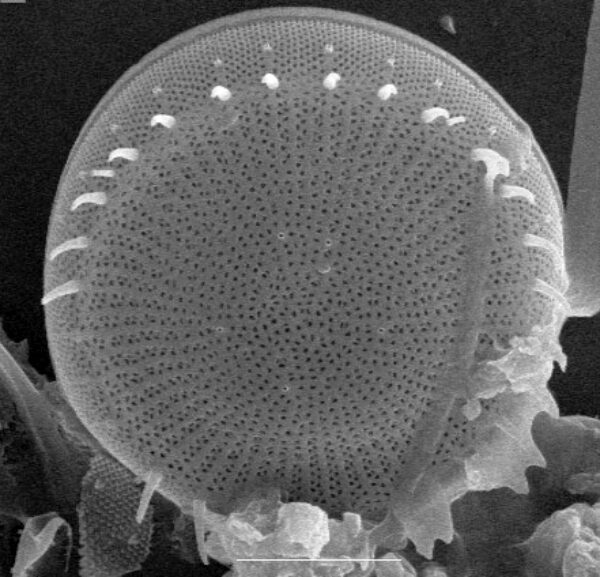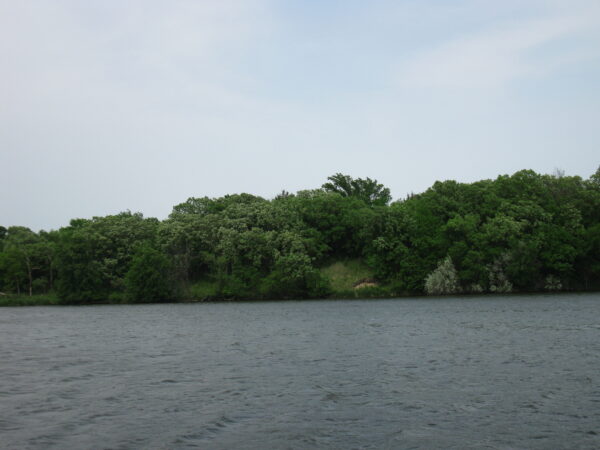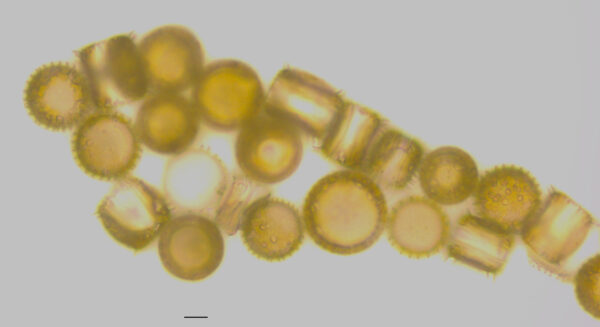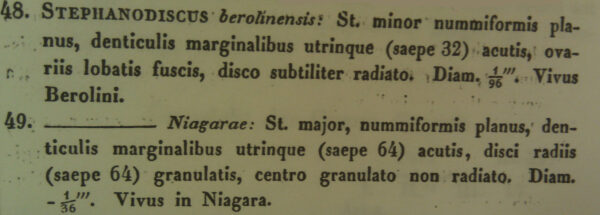Stephanodiscus niagarae
-
Category
-
Diameter21-70 µm
-
ContributorAnna Mengjie Yu - Jun 2011
-
ReviewerMark Edlund - Dec 2012
Identification
Description
Cells discoid or barrel-shaped , with concentrically undulate valves that produce either a convex (scutate) or concave (lacunate) valve face. Valves appear undulate in girdle view in the LM. A ring of spines is present around the valve face, occuring in a single row at the end of every second or third costa at the junction of the valve face and mantle. Areolae are arranged in radiating striae separated by raised hyaline costae. In the valve center the striae are uniseriate, towards the margin striae become biseriate or triseriate. Areolae appear round or angular in the SEM, and round in high focus in LM. Convex domed cribra close the internal opening of the areolae. Fascicles closely spaced, separated by thin costae (also termed hyaline interfascicle). There are 7-9 fascicles in 10 µm, and 11-20 areolae in 10 µm. Every second or third interfascicle with a spine continues over the edge of the valve onto the valve mantle.
Spines are curved and tapered, with a sharply pointed tip. Marginal fultoportulae are present, arranged in a ring around the mantle, always occurring beneath each spine; central fultoportulae occur at the center of the valve face, singly or in a ring. The fultoportulae have 3 satellite pores and external buttresses. One or a few rimoportulae occur on the mantle-face junction. The rimoportulae have tubular external extensions that superficially resembles the spines. The rimortulae, however, are positioned slightly abvalvar the ring of spines. Rimoportulae are difficult to distinguish in LM, but they are shorter, straighter and less tapered than spines.
Autecology
Stephanodiscus niagarae was collected in a plankton tow sample from Grove Lake, Antelope County, Nebraska. The lake habitat temperature was 20.7°C, the water conductivity reached 293 µS/cm, DO showed 7.1 mg/L, and pH showed 9. In specimens from the Iowa Lakeside Lab Herbarium, S. niagarae was found in planktonic and epipelic samples of West Lake Okoboji, Little Miller’s Bay, Fork Des Moines River, and North Spirit Lake in Iowa.
Stephanodiscus niagarae Ehrenberg is a common living and fossil diatom in North America, and occasionally dominates phytoplankton assemblages in lakes throughout North America. Populations in the Great Lakes has been reported ranging from 20 µm to > 100 µm in diameter (Theriot 1983 in Stoermer & Sicko-Goad, 1985). It is abundant in North American Quaternary fossil deposits and also has been reported as a fossil from Asia, Africa, and Europe. Stephanodsicus niagarae was found in a paleolacustrine deposit in Jingyu County, Jilin Province, northeastern China; the central fultoportula count is roughly intermediate between that for living North American specimens of S. niagarae and fossil European specimens of the type of S. rotula, suggesting the possibility of evolutionary intermediacy (Theriot et al., 1988). A study of correlation matrix of 16 characters of 129 S. niagarae specimens from 14 lentic North American habits revealed variation in silification; larger valves more heavily silicified than smaller ones, and specimens from lakes with high ambient silicon: phosphorus ratios were more heavily silicified (Theriot, 1987).
-
Size Range, µm3
-
Motility
-
Attachment
-
Habitat
-
Colony
-
BCG
-
Waterbody
-
Distribution
- Learn more about this
Citations & Links
Citations
-
Publication Link: 10.1111/j.0022-3646.1991.00780.x
-
Publication Link: 10.1080/0269249X.1994.9705288
Links
-
Index Nominum Algarum
-
GenBank
-
North American Diatom Ecological DatabaseNADED ID: 64001
Cite This Page
Mengjie Yu, A. (2011). Stephanodiscus niagarae. In Diatoms of North America. Retrieved April 18, 2024, from https://diatoms.org/species/stephanodiscus_niagarae
Responses
The 15 response plots show an environmental variable (x axis) against the relative abundance (y axis) of Stephanodiscus niagarae from all the stream reaches where it was present. Note that the relative abundance scale is the same on each plot. Explanation of each environmental variable and units are as follows:
ELEVATION = stream reach elevation (meters)
STRAHLER = distribution plot of the Strahler Stream Order
SLOPE = stream reach gradient (degrees)
W1_HALL = an index that is a measure of streamside (riparian) human activity that ranges from 0 - 10, with a value of 0 indicating of minimal disturbance to a value of 10 indicating severe disturbance.
PHSTVL = pH measured in a sealed syringe sample (pH units)
log_COND = log concentration of specific conductivity (µS/cm)
log_PTL = log concentration of total phosphorus (µg/L)
log_NO3 = log concentration of nitrate (µeq/L)
log_DOC = log concentration of dissolved organic carbon (mg/L)
log_SIO2 = log concentration of silicon (mg/L)
log_NA = log concentration of sodium (µeq/L)
log_HCO3 = log concentration of the bicarbonate ion (µeq/L)
EMBED = percent of the stream substrate that is embedded by sand and fine sediment
log_TURBIDITY = log of turbidity, a measure of cloudiness of water, in nephelometric turbidity units (NTU).
DISTOT = an index of total human disturbance in the watershed that ranges from 1 - 100, with a value of 0 indicating of minimal disturbance to a value of 100 indicating severe disturbance.

Stephanodiscus niagarae
- Valves concentrically undulate
- Areolae round
- Areolae 11-20 in 10 µm
- Marginal spines placed every 2-3 costae
Valves are concentrically undulate, so that only the valve margin or the valve center is in focus at one time. The areolae are round and arranged in fascicles of radial striae, separated by raised costae. Areolae are 11-20 in 10 µm. Striae are uniseriate in the center valve and biseriate near the margin. Marginal spines are present....
 Diatoms of North America
Diatoms of North America